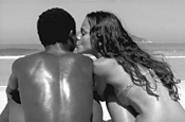The film's title refers to Rio de Janeiro's most notorious slum. A model housing project when the government built it in the 1960s, the favela fell victim to teenaged drug dealers in the mid-'70s. Within 10 years, the situation had escalated into all-out war among rival street gangs.
City of God native Paulo Lins chronicled his neighborhood's descent into bloodshed and chaos in a massive, 700-page novel, which became the basis for the film. Emotionally gripping from start to finish, the movie presents an electrifying and unforgettable look at life in a place that God has all but forgotten.
The story is told through the eyes of Rocket (Alexandre Rodrigues), who, in the film version, yearns to be a photographer (rather than the writer Lins became, partially because it offered more cinematic possibilities). After a short but snazzy prelude, set in the 1980s, the film jumps back to the 1960s, when Rocket is a sweet, shy child of eight. When he sees his first camera, he knows what he wants to do with his life.
This section, bathed in a kind of yellow glow, revolves around the Tender Trio, three teenaged friends -- one of them Rocket's older brother -- who hold up delivery trucks and engage in other petty crimes, but who are not hardened criminals. A sense of naïveté washes over this section, reminiscent of old American Westerns. The boys hold up delivery trucks that dare to venture into the favela. Covering their faces with kerchiefs in the style of stagecoach robbers, they run alongside each vehicle, waving pistols and imagining themselves to be gunmen on horseback.
The film then jumps to the mid-1970s, when Rocket is 14 or 15. This marks the beginning of the psychedelic era. Everyone is smoking marijuana, and color suddenly floods the screen.
This is a happy time for Rocket and his friends. Rocket still longs to buy a camera and become a photographer. His childhood friend Li'l Zé (Leandro Firmino da Hora) has a very different ambition: to become the most feared drug dealer in City of God. With several murders already under his belt, he is well on his way to achieving his dream. Li'l Zé's best friend Benny (Phellipe Haagensen) is also a drug dealer but more laid back, the kind of guy who is liked by everybody.
The story's change in mood and tone is mirrored in the camera movements and editing style. The smooth, steady shots of the first section are replaced with slightly off-kilter framing and a hand-held camera. Things become even more urgent in the third section, the 1980s, when cocaine takes hold in the favela and drug wars break out among rival gangs. Camera movements are more volatile, and shots are frequently out of focus, capturing the cold, tense, dangerous world that has suddenly erupted.
Brazilian director Fernando Meirelles decided early on to cast the picture with real kids from the actual ghetto, many of them homeless and living on the streets. It was a ballsy move -- and absolutely the right one. The performances that he and co-director Katia Lund got out of these kids are nothing short of extraordinary. Of course, many of them were just copying the behavior and actions that they see around them every day, a harrowing reality from which these children cannot escape.
A second key decision for Meirelles and Cesar Charlone, his brilliant cinematographer, was not to glamorize the violence. Yes, the film is brutally violent, but the director eschews the exploding bodies and slow-motion ballets of death, so common in Hollywood movies. Instead, he wanted to suggest the disquietingly casual nature of violence that Lins describes in his novel.
Perhaps the film's most visually stunning sequence is the transition linking the film's five-minute prelude to the 1960s phase of the story. The mood is festive. The neighborhood is preparing food for an outdoor barbecue, killing and plucking chickens, and throwing the fresh meat on the grill. One of the birds, sensing its fate, escapes down an alley, with 18-year-old Li'l Zé and his gang in hot pursuit, guns drawn. As they round a corner, they come upon Rocket, who is walking down the middle of the street, holding his now-ubiquitous camera. Everyone yells at him to grab the chicken. As he attempts to sneak up on it, he suddenly sees all the gang members freeze. He looks behind him to find out what they're staring at and spots a line of policemen about to square off against Li'l Zé's gang. Rocket is caught dead-center between the two groups.
The scene, of course, is a metaphor for Rocket (although we don't realize it until later). Rocket is like those chickens, who can't escape their fate. And yet, somehow, this one chicken does escape.










